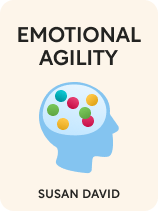

This article is an excerpt from the Shortform book guide to "Emotional Agility" by Susan David. Shortform has the world's best summaries and analyses of books you should be reading.
Like this article? Sign up for a free trial here.
Are you honest with yourself about your emotions? Do you allow yourself to feel? Do your values lead toward your ideal future?
You don’t have to let narratives—or your emotional responses to them—control you. Instead, you can be emotionally agile—viewing events and emotions objectively and responding deliberately. To do this, label your emotions, accept your emotions, view your emotions objectively, and choose your values.
Keep reading to learn how to become emotionally agile by engaging in this four-part process put forth by Susan David in her book Emotional Agility.
Step 1: Label Your Emotions
The first step to becoming emotionally agile is labeling your emotions—that is, using honest, specific language to describe what you’re feeling. David argues that the combination of honesty and specificity forces you to understand the exact nature of your emotions, no matter how uncomfortable. Otherwise, you might feel tempted to ignore them or to use vague words to avoid painful vulnerability.
For example, you might carry a decades-old burden of shame for never completing your education. You’ve previously talked about these feelings in a way that lacks specificity: “I wish I’d ‘done things differently’ in life.” Based on this generality, you think a career change will make you feel better—but this doesn’t address your feelings of shame and therefore doesn’t help. On the other hand, labeling your emotions precisely might mean saying, “For decades, I’ve regretted dropping out of college. I’ve felt shame for failing and wasting my parents’ money. Every day since then, I feel sick at the mention of school or career growth.”
Step 2: Accept Your Emotions
Once you’ve labeled your emotions, you can begin the second step of becoming emotionally agile: accepting your emotions. This means compassionately giving yourself permission to feel, struggle, and fail. You’ll acknowledge that neither the act of feeling unwanted emotions—particularly guilt and shame—nor the act of believing inaccurate narratives make you less of a person.
To achieve acceptance and self-compassion, David encourages you to look at your own faults and flaws as you would those of a loved one or a young child—with forgiveness. This strips away the accusatory power that self-narratives often hold.
In our example of feeling guilty about dropping out of college, you might be telling yourself that failing in the past makes you a failure. Self-compassion in this case might mean saying, “I regret my past decision, but I can still learn from it and make different choices in the future.” You acknowledge your past mistakes without believing the lie that you should feel guilt or shame forever.
David notes that accepting your emotions can help you use them for their evolutionary purpose: prompting behaviors that can improve your life. Regret from dropping out of college might prompt reflection and planning for a return to school or an attempt at moving up in your career—without the fear that you’re a failure who’ll never succeed in new ventures.
Step 3: View Your Emotions Objectively
Labeling and accepting your emotions goes a long way to reducing their intensity and power over you—which makes it easier to take the third step of becoming emotionally agile: viewing your emotions from an objective perspective. David says that, when you’re able to look at your emotions—and the narratives they come from—from a rational, objective standpoint, you’ll be able to see the flaws in your narrative and in your emotional reactions to it.
For example, if someone cuts you off in traffic, you might feel anger as your brain forms the narrative, “He deliberately cut in front of me!” For the rest of your commute, you brood in your anger. However, if you think about the situation objectively, you’ll realize that the other driver likely wasn’t trying to mistreat you—he simply didn’t see you—and there’s no reason to be so angry.
Additionally, understanding that your emotions are temporary experiences, not absolute truths about your life helps lessen the power of the narratives you hold about yourself. For example, the fact that you feel sad in reaction to an event doesn’t mean you can’t handle stress or that your situation is hopeless. It only means that, at that moment, you feel sad.
David offers two techniques for gaining an objective perspective: mindfulness for handling your present emotions and journaling for handling your past emotions.
Handle Present Emotions With Mindfulness
Mindfulness is the act of paying attention to your senses, emotions, and surroundings without judgment. David suggests that, by paying attention to the stimuli in your surroundings—and the emotions that arise from your thoughts about these stimuli—you can weaken your instinct to believe your narratives. Your brain avoids mindfulness to save you mental energy in everyday life: If you can pour a glass of water without paying close attention, you’ll likely do so on autopilot every time you’re thirsty. While on autopilot in this way, you’re more susceptible to your narratives and emotions controlling you.
However, David says you don’t need to be mindful at every moment in order to ward against narrative and emotional control. Instead, pay deliberate attention to your surrounding stimuli from time to time throughout the day. You’ll gradually become more mindful with practice.
Handle Past Emotions With Journaling
Journaling means writing down your experiences, feelings, and thoughts—or narrating them into a voice recorder. Unlike mindfulness, which deals with present emotions, journaling is a technique for processing past emotions and narratives. David says journaling naturally leads you to label and accept your emotions, offering you a more objective understanding of those emotions. Journaling can reduce the power of lifelong emotions and narratives, preparing you to actively choose your responses to emotions in the future.
Step 4: Choose Your Values
Now that you’ve learned how to take back control from your narratives and emotions, you can move on to the final step of becoming emotionally agile: choosing your values. Values are the guiding principles that shape your behaviors and decisions, the things in life that you believe are most important. David explains that everyone has values, whether they realize it or not—though for most people, many of these values are intrinsically tied to unconscious narratives.
For example, your extended family might consider “family” a core value—and look down on you for cutting an abusive parent out of your life. You might then feel tempted to believe the narrative that you must always remain in contact with your family, no matter what.
David recommends contemplating the values others impose on you. Examine your behavior across different settings in your life. Do you act or speak differently around friends, family, and others? If so, why? Does this arise from a desire to appease or impress others who value certain behaviors more than you do?
Choose and Pursue Your Personal Values
David says that, besides the values you receive from others, you also carry a set of personal, unique values that, when pursued, will give you a sense of fulfillment and purpose. When you objectively understand your emotions, you don’t instinctively believe what your narratives and emotions say you should value. You’re free to purposely determine—and live by—your personal values.
David gives advice on how to determine your values: Ask yourself what life you’d pursue if you had no obstacles or stress standing in your way. When you go to bed each night, think over your day and decide what parts of it were valuable and which didn’t feel fulfilling. Imagine what your future self might think of your current values—and where those values will lead you in the future.
Exercise: Assess Your Emotional Agility
Consider a recent event to which you reacted poorly in a way you later regretted. This exercise will help you reflect on the event—and determine a better course of action in the future—using the principles of emotional agility.
- What was the situation and how did you feel in the moment? Be specific in labeling your emotions. (For example, you made plans to meet up with a friend for coffee, and she brought her friend without asking you. You were annoyed, so you didn’t talk much and left early. Upon reflection, your emotions were more accurately those of hurt and anxiety.)
- Try to view the situation objectively. What narrative or explanation lay behind your emotion? Can you identify another, more objective explanation? (You told yourself that your company isn’t enough for your friend—she felt that she needed someone else there to have a good time. However, she may have brought her friend because you have a lot in common and she thought you’d hit it off.)
- How did your response align—or not align—with your values? (Your actions of shutting down and leaving early didn’t align with your values of connection and assuming generous intent.)
- How could you react to a similar situation in the future in a way that aligns with your values? (In the future, you’ll assume that your friend is bringing others along for your benefit, and you’ll be sure to let her know ahead of time if you prefer a coffee date just between the two of you.)

———End of Preview———
Like what you just read? Read the rest of the world's best book summary and analysis of Susan David's "Emotional Agility" at Shortform.
Here's what you'll find in our full Emotional Agility summary:
- Why most people react instinctively rather than objectively
- How to live according to your values to create the life you want
- How to handle your emotions better using mindfulness techniques






